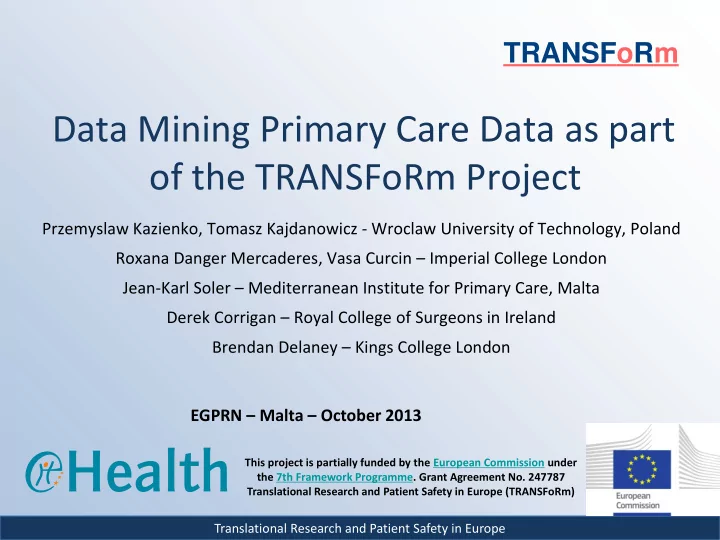

TRANSFoRm Data Mining Primary Care Data as part of the TRANSFoRm Project Przemyslaw Kazienko, Tomasz Kajdanowicz - Wroclaw University of Technology, Poland Roxana Danger Mercaderes, Vasa Curcin – Imperial College London Jean-Karl Soler – Mediterranean Institute for Primary Care, Malta Derek Corrigan – Royal College of Surgeons in Ireland Brendan Delaney – Kings College London EGPRN – Malta – October 2013 This project is partially funded by the European Commission under the 7th Framework Programme. Grant Agreement No. 247787 Translational Research and Patient Safety in Europe (TRANSFoRm) Translational Research and Patient Safety in Europe
Why data mine? • Large repositories of potentially useful coded Primary Care data exist such as the TRANSHIS project • Can be used to derive empirical evidence, sensitive to different populations, to support the goal of practicing “evidence based medicine” • In the context of TRANSFoRm, can provide the data necessary to populate actionable models of evidence from dynamic sources, rather than static literature based sources Translational Research and Patient Safety in Europe
Data mining steps 1 - Derive 2 - Calculate TRANSHIS Association Quality Rules Measures 3 - Filter based on 4 - Clinical 5 - Evidence High Quality Rules Review Transfer to Models Translational Research and Patient Safety in Europe
How to data mine TRANSHIS? Clinician Patient Time Episode of Care Encounter 1 RFEs Diagnosis 1 Diagnostic Cues Encounter 2 Diagnosis 2 RFEs Diagnostic Cues ..... Encounter n RFEs Diagnosis n Diagnostic Cues Translational Research and Patient Safety in Europe
Step 1 - Association Rules Structure - RFEs, Diagnostic Cues, Demographic Features --------> Diagnosis Antecedent Variables --------- > Consequent Variable e.g. Abdominal Pain, Dysuria, Fever, Female Urinary Tract Infection ICPC2 Coded = D06, U01, A03, F -> U70 – Apriori Algorithm implemented using tool called KNIME Translational Research and Patient Safety in Europe
Step 2 - General Quality Measures • Itemsets characterization – Support – no of cases containing rule antecedents • Rules characterization – Lift – how much more likely antecedents and consequent occur together than if statistically independent – Confidence – probability of consequent occurring given the antecedent Translational Research and Patient Safety in Europe
Step 2 -Bayesian Quality Measures • Consequent (disease) interest – Prior probability – prevalence of disease • Variables characterization – Likelihood ratios (+/-) Translational Research and Patient Safety in Europe
Step 3, 4 -Web rule review tool • Goal: Analyse data mining results from TRANSHIS to identify clinically significant rules Features: – Full rule view – Sorting rules – Multivariate filtering by quality measures – Annotation of interesting findings – Transfer of rules to evidence ontology service Translational Research and Patient Safety in Europe
Translational Research and Patient Safety in Europe
TransHIS analysis example Rules x => U71 , (Cystitis/urinary infection, other) • U01 – Dysuria • U02 – Urinary Frequency • U06 – Haematuria • A03 – Fever • D06 – Abdominal pain localised • Important cues compare favourably with literature – e.g. JAMA reviews Translational Research and Patient Safety in Europe
Rule transfer to Evidence Model Translational Research and Patient Safety in Europe
Rule transfer to Ontology Translational Research and Patient Safety in Europe
Evidence Representation RFE -Frequency RFE - U02 Dysuria U01 RFE - hasRFE Abdominal Pain D06 hasDifferentialDiagnosis Quantification - Support x Confidence y Lift z hasDemographic Urinary Tract isQuantificationOf Infection U71 Symptom - Fever A03 Demographic - hasSymptom Malta Female Translational Research and Patient Safety in Europe
Conclusions • Feasible to identify clinically meaningful evidence based on coded primary care repositories of data • Primary Care context is crucial - dependent on how common the condition occurs in primary care e.g. UTI vs Ectopic Pregnancy • May become more feasible for uncommon cases when data from more countries are aggregated together to give larger volumes of data for uncommon cases • The TRANSFoRm evidence models can be used to represent and query this data for decision support Translational Research and Patient Safety in Europe
Derek Corrigan: derekcorrigan@rcsi.ie www.hrbcentreprimarycare.ie www.transformproject.eu 11 Translational Research and Patient Safety in Europe
Recommend
More recommend